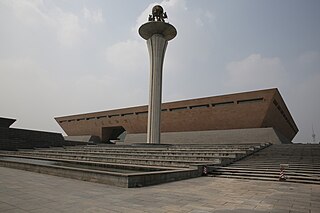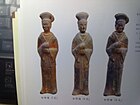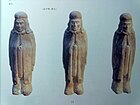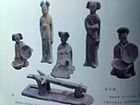
Terracotta, terra cotta or terra-cotta, a type of earthenware, is a clay-based unglazed or glazed ceramic, where the fired body is porous. Terracotta is the term normally used for sculpture made in earthenware, and also for various practical uses including vessels, water and waste water pipes, roofing tiles, bricks, and surface embellishment in building construction. The term is also used to refer to the natural brownish orange color of most terracotta, which varies considerably.

The Liang dynasty (502–557), also known as the Southern Liang, was the third of the Southern Dynasties during China's Southern and Northern Dynasties period. It was located in East China and South China, and replaced by the Chen dynasty in 557. The small rump state Western Liang (555–587), located in Central China, continued until its annexation in 587.

Shaanxi History Museum, which is located to the northwest of the Giant Wild Goose Pagoda in the ancient city Xi'an, in the Shaanxi province of China, is one of the first huge state museums with modern facilities in China and one of the largest. The museum houses over 370,000 items, including murals, paintings, pottery, coins, as well as bronze, gold, and silver objects. The modern museum was built between 1983 and 2001 and its appearance recalls the architectural style of the Tang Dynasty.

The Northern Qi was one of the Northern dynasties of ancient China history and ruled northern China from 550 to 577. The dynasty was founded by Emperor Wenxuan, and it was ended following attacks from Northern Zhou.
Emperor Xiaojing of Eastern Wei ( 魏孝靜帝) (524–552), personal name Yuan Shanjian (元善見), was the only emperor of the Eastern Wei – a branch successor state to Northern Wei. In 524, Northern Wei's paramount general Gao Huan, after Emperor Xiaowu had fled the capital Luoyang to reestablish the imperial government at Chang'an, made Emperor Xiaojing emperor as Emperor Xiaowu's replacement, and moved the capital from Luoyang to Yecheng, thus dividing Northern Wei into two, and Emperor Xiaojing's state became known as Eastern Wei. Although Gao Huan treated him with respect, real power was in the hands of Gao Huan, and then Gao Huan's sons Gao Cheng and Gao Yang. In 550, Gao Yang forced Emperor Xiaojing to yield the throne to him, ending Eastern Wei and establishing Northern Qi. Around the new year 552, the former Emperor Xiaojing was poisoned to death on the orders of the new emperor.
Empress Gao was an empress of the Chinese/Xianbei dynasty Eastern Wei — a branch successor state to Northern Wei. Her husband was Emperor Xiaojing, Eastern Wei's only emperor.
Emperor Wenxuan of (Northern) Qi ( 齊文宣帝) (526–559), personal name Gao Yang, courtesy name Zijin (子進), Xianbei name Hounigan (侯尼干), was the first emperor of the Northern Qi. He was the second son of Eastern Wei's paramount general Gao Huan, and the death of his brother and Gao Huan's designated successor Gao Cheng in 549 became the regent of Eastern Wei. In 550, he forced Emperor Xiaojing of Eastern Wei to yield the throne to him, ending Eastern Wei and starting Northern Qi.
Princess Pingyi (馮翊公主), later honored as Empress Wenxiang (文襄皇后), formally posthumously honored as Empress Jing by Northern Qi, was a princess of the Chinese dynasty Northern Wei and its branch successor state Eastern Wei. She was the sister of Emperor Xiaojing of Eastern Wei, and the wife of Eastern Wei's paramount official Gao Cheng, son of Gao Huan.
Yujiulü Anluochen (?-554) was the last khagan of the Rouran (553-554) in the east. He was the son of Yujiulü Anagui.
Lou Zhaojun, formally Empress Ming, was an empress dowager of the Chinese dynasty Northern Qi. She was the wife of Gao Huan, the paramount general of Northern Wei and its branch successor state Eastern Wei, and during Gao Huan's lifetime was already influential on the political scene. After Gao Huan's death, she continued to exert influence through the regency of her son Gao Cheng, and then as empress dowager after another son Gao Yang seized the throne from Emperor Xiaojing of Eastern Wei and established Northern Qi. She continued to serve as grand empress dowager through the reigns of Gao Yang's son Emperor Fei, and then again as empress dowager during the reigns of two more of her own sons, Emperor Xiaozhao and Emperor Wucheng.
Xiao Yuanming (蕭淵明), courtesy name Jingtong (靖通), often known by his pre-ascension title of Marquess of Zhenyang (貞陽侯), at times known by his post-removal title Duke of Jian'an (建安公), honored Emperor Min (閔皇帝) by Xiao Zhuang, was briefly an emperor of the Chinese Liang Dynasty. He was the nephew of the founding emperor Emperor Wu. In 555, with Liang in disarray after Western Wei had captured and killed Emperor Yuan, Northern Qi, which had held Xiao Yuanming as an honored captive since 547, forced the general Wang Sengbian to accept Xiao Yuanming as emperor. Soon, however, Wang's subordinate Chen Baxian killed Wang and removed Xiao Yuanming from the throne, replacing him with Emperor Yuan's son Xiao Fangzhi. Xiao Yuanming died the following year.
Emperor Xiaozhao of Northern Qi ( 齊孝昭帝) (535–561), personal name Gao Yan (高演), courtesy name Yan'an (延安), was an emperor of Northern Qi. He was generally considered a capable ruler, but ruled for less than two years before dying from injuries suffered from falling off a horse. Northern Qi would not have another capable ruler after his death.
Empress Yuan was an empress of the Chinese dynasty Northern Qi, known at times semi-formally as Empress Shuncheng (順成皇后). Her husband was Emperor Xiaozhao.
Empress Hulü was an empress of the Chinese dynasty Northern Qi. She was Gao Wei's first empress, and she was a daughter of the general Hulü Guang.
Gao Shaoyi (高紹義), often known by his princely title of Prince of Fanyang (范陽王), was an imperial prince of the Chinese dynasty Northern Qi, who claimed the Northern Qi throne in exile under the protection of Tujue after rival Northern Zhou seized nearly all of Northern Qi territory and captured the emperors, Gao Shaoyi's cousin Gao Wei and Gao Wei's son Gao Heng in 577. In 580, Tujue, after negotiating a peace treaty with Northern Zhou, turned Gao Shaoyi over to Northern Zhou, and he was exiled to modern Sichuan, ending his claim on the Northern Qi imperial title. Most traditional historians do not consider Gao Shaoyi a true emperor of Northern Qi.

The Qianling Mausoleum is a Tang dynasty (618–907) tomb site located in Qian County, Shaanxi province, China, and is 85 km (53 mi) northwest from Xi'an. Built in 684, the tombs of the mausoleum complex house the remains of various members of the House of Li, the imperial family of the Tang dynasty. This includes Emperor Gaozong, as well as his wife, Wu Zetian, who assumed the Tang throne and became China's only reigning female emperor from 690–705. The mausoleum is renowned for its many Tang dynasty stone statues located above ground and the mural paintings adorning the subterranean walls of the tombs. Besides the main tumulus mound and underground tomb of Emperor Gaozong and Wu Zetian, there are 17 smaller attendant tombs, or peizang mu. Presently, only five of these attendant tombs have been excavated by archaeologists, three belonging to members of the imperial family, one to a chancellor, and the other to a general of the left guard. The Shaanxi Administration of Cultural Heritage declared in 2012 that no further excavations would take place for at least 50 years.

Luoyang Museum is a historical museum in Luoyang, Henan Province, China. Situated in the Yellow River valley. It offers exhibits of the rich cultural heritage of Luoyang, a major Chinese cultural centre, which was the capital of numerous Chinese dynasties including the Eastern Zhou and the Eastern Han.

Standing Horse is a Tang dynasty tomb figure, created during the Tang dynasty in China. In ancient China, numerous tomb figurines and other artefacts were designed specifically to be buried with the deceased in large burial mounds. This large figurine is glazed with the iconic tri-colour glaze, also known as Sancai, which is a glazing technique that is synonymous to the Tang dynasty.
Zhao Kangmin was a Chinese archaeologist best known for discovering and naming the Terracotta Warriors of the Mausoleum of Qin Shi Huang, one of the most famous archaeological discoveries of the 20th century. Fragments of the warriors were initially found in 1974 by farmers digging a well, but Zhao was officially credited as the discoverer as he was the first to recognize the significance of the fragments and reconstruct them into life-size statues. He also led or participated in many other excavations and served as a longtime curator of the Lintong Museum.

Xuzhou Museum is a comprehensive museum of historical Chinese art in Xuzhou, Jiangsu, China, which was founded in 1959. Originally the site of one of the Qianlong Emperor's Palaces at the northern foot of Yunlong Mountain, the Xuzhou Museum was established in 1959, expanded in 1999, then rebuilt and extended in 2010, with work completed in 2012. At present, it encompasses an area of 40,000 square meters. The museum includes a four-story exhibition building and administers the Xanadu Palace and Stone Tablet Garden of the Emperor Qianlong of the Qing Dynasty built for his inspection tour of the south of the Yangtze River in 1757. It also administers three tombs of the Pengcheng King of the Eastern Han Dynasty in Tu Shan, that includes an excavation site of Han Dynasty terracotta warriors and horses.













